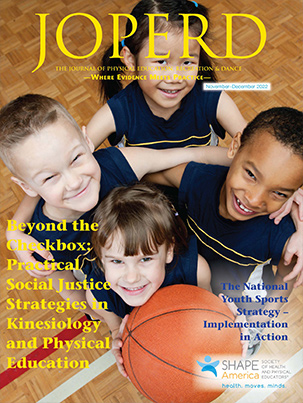 JOPERD Table of Contents
JOPERD Table of Contents
Beyond the Checkbox: Practical Social Justice
Strategies in Kinesiology and Physical Education
Kathleen McCarty, Layne Case & Winston Kennedy

The academic community has taken note of the recent unrest that arose due to the killing of unarmed Black people by police in the United States, namely, George Floyd, Breonna Taylor and too many others. This is evident by the growing numbers of “allyship” and calls for immediate trainings that support marginalized communities. Despite these recent efforts, questions remain as to the sustainability and impact on higher education (Frank, 2018). This pattern of events, galvanized by racialized injustice, has unfolded before. Historically, it has been witnessed as a pendulum — injustice and harm done to minoritized communities is met with social surprise and immediate advocacy for change, followed by a gradual return to the status quo for the majority, namely, those in power. The pendulum swings back and the cycle repeats years later (e.g., consider the beating of Rodney King in 1991, the fatal shooting of Trayvon Martin in 2012, the killing of George Floyd in 2020). Given the widespread, frequent and clear calls for diversity, equity and inclusion across higher education settings, there is a gap in action that indicates a repeat of the “return to normalcy” pendulum swing.
In the physical education (PE) literature, social justice has been described as an umbrella term for various culturally responsive and antiracist pedagogies that share the goal of preparing educators to “recognize, name, and combat” inequities toward marginalized groups (Spalding et al., 2010, p. 191). However, like the broader social pendulum swings, the field has seen cycles as scholars have advocated for socially just pedagogy in PE since the 1980s with little progress (Fitzpatrick, 2019; Kirk, 1986). As such, several goals exist within the social justice research agenda, including defining relevant teaching (Chubbuck, 2010), assessing teacher educator views and attitudes toward justice pedagogies (Burden et al., 2012; Walton-Fisette et al., 2018), and examining the effects of equitable teaching strategies for marginalized groups (Burden et al., 2012; Chubbuck, 2010; WaltonFisette et al., 2018). Over time, this agenda has expanded to critique the lack of progress made in these areas, express the need to integrate the social justice agenda into PE curriculums, and attract those in the field to prioritize equity and diversity (Azzarito et al., 2017; Burden et al., 2012; Fitzpatrick, 2019; Frank, 2018; Tinning, 2002; WaltonFisette et al., 2018). Despite this long history of critical scholarship in PE and related fields (e.g., kinesiology, exercise science), calls for practical change remain, with little attention given to offering practical solutions (Fitzpatrick, 2019; Walton-Fisette & Sutherland, 2018)
To read the rest of this article, click here to download a pdf.